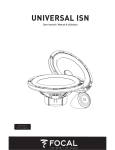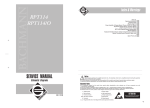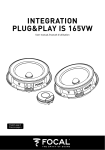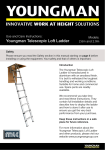Download Hi-fi User manual - Pdfstream.manualsonline.com
Transcript
Hi-fi User manual JMlab® is a trademark of Focal-JMlab® 15, rue Jean-Claude Verpilleux - BP 201 - 42013 Saint-Etienne cedex 2 - Tel. +33 4 77 43 16 16 - Fax +33 4 77 37 65 87 - www.focal-jmlab.fr Hi-fi 2 User manual Dear Music Lover, Thank you very much for choosing a JMlab loudspeaker. We are pleased you have chosen one of our products and trust you will enjoy it for years to come. JMlab has worked very hard to become not only the premier French loudspeaker supplier but one of the few companies in the world to totally control research, design and manufacturing. This capability, coupled with our total dedication to your satisfaction, assures you of the highest possible quality in every product we offer. For example, each individual driver in your JMlab system is designed and manufactured in the extensive facilities of our prestigious Focal division. JMlab manufactures and tests every speacker system individually to assure absolute quality and conformity to strict performance parameters. Our ethos has not changed since the company’s foundation: to design higly efficient products using only the finest components. The expression “The Spirit of Sound” is much more than just a leitmotif in our logo. Instead, it represents a veritable signature in sound characterized by a vibrant fidelity to the richness and dynamics, the very life, of music. It is sound that is, truly, essential to all JMlab products. Numerous innovations such as the dual voice coil, Polykevlar®, Polyglass®, the inverted dome tweeter, the “W”® sandwich cone materials, the OPC® crossovers and the “gamma” structure are at the basis of JMlabs sterling reputation, which has been bolstered by numerous international awards. In Japan, JMlab products have been awarded the exclusive COTY (Component of the Year) Award, while in the US the Grande Utopia and the Utopia have been rated at the top of Stereophile magazines Class A Recommended components listing in 1996 and 1998 respectively. To commemorate their 15 year, JMlab developed one of the most prestigious loudspeakers ever built: the Grande Utopia represents the best of the technical advancements at Focal since 1980. The enthusiastic worldwide acclaim for this product incited us to develop an entire family of Utopia systems, comprising now nine models which are offering a choice of reference in real high end and home cinema (in 2001 DTS selected the Grande Utopia as acoustic references). Several international awards from the United States, United Kingdom (recommended product), Japan (Components of the year), Germany (Referenz Spitzenklasse) illustrate our know how. Many prestigious international loudspeaker manufacturers have taken notice of these advanced products and have selected Focal drivers for use in their most ambitious designs. More recently, we have applied our expertise to automotive high fidelity to introduce Focal Audiomobile. These drivers are rapidly gaining acceptance with the most demanding clientele as excellent examples of highly reliable and efficient components. The numerous titles of world champions won at IASCA world finals witness our advanced technology. In closing, we would like to thank you once again for putting your trust in us. We hope that these loudspeakers will bring you endless hours of listening pleasure. Yours faithfully, Jacques MAHUL President 3 Hi-fi User manual JMlab installation comments To take full advantage of the qualities of your JMlab speakers it is essential that you be aware of the influence of the sonic features of your listening area to maximize positioning. 1. A few basic rules of acoustics Sound travels through the air. The lower the signal the longer the wavelength; the higher the signal the shorter the wavelength. Consequently, there is little room for manoeuvering in certain rooms with regard to bass reproduction unlike the midrange and treble as modest rearranging may solve defects such as tonal balance and imaging. Following are a few landmarks to set the guidelines : • The sizes of the room plays an important role as this determines its resonance mode. Suffice it to say that a rectangular room is better than a square room (with a cubic shape being the worst configuration). For information purposes, a size ratio such as the following will give outstanding results: ceiling height x 1.9 = length and ceiling height x 1.4 = width. For instance, a 9’ ceiling would suggest a room 17’ in length and 12-1/2’ wide. • The coverings on the walls, floor and ceiling contribute directly to the sonic characteristics of the room. Certain wall materials such as carpeting or soft wood will absorb high frequencies generate softer high frequencies while favoring the bass and lower midrange registers because of the level reduction of the higher frequencies. A tiled floor, glazed partitions and hard smooth surfaces will reflect sound causing stress in the upper part of the spectrum. The sound will be clearer and brighter. In the final analysis the listening room should be neither too reflective (aggressive environment) nor too absorbent (damped environment). A pleasant sound is a balanced sound. 2. The acoustic speakers’ place The positioning of your acoustic speakers is critical to the comfort and the quality of listening, sound image and tonal balance. • Sound image The stereophonic principle allows creation of a realistic positioning of the various musicians in the space in front of the listener in width as well as in depth. In order to adhere to this principle, both speakers should be arranged according to the following elementary rules: • The listening area is located at the summit of a triangle whose two other points of intersertion is determined by the position of each speaker. • The triangle should be neither too open (obtuse) nor too closed (acute): optimium would be an equilateral triangle. For good reproduction of the sound image, select the positions in your room capable of best satisfying the various following standards: • The wall to the rear of the speakers should be reflecting so that the sound image exhibits satisfying volume and width (soundstage). Preferably this will be a smooth wall with as little furniture as possible. • The wall to the rear of the listener should be absorbing in order to avoid reflections which may limit the impression of depth of the sound image. Preferably this wall will have wall covering, open book shelves, tapestries, etc • The side wall should by symmetrical from an acoustic point of view for proper centering of the sound image. Ideally this wall will be a reflecting wall perhaps with windows: any absorbing materials such as tapestries of book shelves should be avoided (avoid reflective large surfaces, glass windows on one side with opposed absorptive surfaces (cloth, bookshelves) on the other). • Finally, if your ceiling is of a reflecting material such as plaster, place carpets or rugs on your floors. If the ceiling is an absorbing material such as acoustic tiles, the floor should be somewhat reflecting such as wood parquet or tile. Definition of the optimum listening area Ideally try to be as close as possible of this configuration with lateral walls of same acoustical nature. 4 Hi-fi User manual Obviously these are only guidelines because in normal situations there may be prevailing conditions which will not permit significant alterations. You sould simply take these criteria into account in order to assist you in determining the best location for you speakers. Their accurate positioning will give the best possible tonal balance, an aspect which will be discussed in detail hereunder. • Tonal balance This parameter is directly related to the linearity of restitution of your listening room. The various frequency registers must be reproduced at the same level so that the tonal color of the individual instruments will be respected. For instance, a swollen bass range will mask the treble range and the tones will be dull and weak. A stressed midrange and treble will result in harsh tonal colors which lack fullness thus producing an unpleasant listining experience. The purpose of the positioning is to maintain the response primarily in the bass range. Your JMlab speakers have been designed with great accuracy and on the basis of extreme neutrality. Because of the important wavelengths in the bass range, the sound will be amplified in this frequency area by reflection from adjacent wall and/or floors if the base driver is situated as follows: • Quite close to a wall, such as a floor, the bass range will be amplified by 3dB (doubled). • Quite close to two walls, such as the floor and the wall opposed to the listener, the bass range will be amplified by 6dB (quadrupled). • Quite close to three walls, such as a corner, the bass range will be amplified by 9dB. Consequently, it is well-advised to situate the speakers away from the walls and the floor as much as possible so as to not alter the response because of unduly swollen bass frequencies. These easy rules will help steer you in the right direction : • The center plane of the speaker (between the bass driver and tweeter in a two-way system or between the midrange driver and tweeter in three-way or four-way system) should be at approximately the same height as the listener’s ear ; i.e. between 60cm and 120cm (24” and 48”) high. Stands should be selected accordingly for smaller speakers and floor-standing columns should be on cones or spikes. • The clearance with respect to the wall behind the speaker and the closest side wall depends on the size and configuration of the listening room. The smaller the room the less the speaker can be cleared away from the rear and side walls but the furniture arrangement may place restraints on your positioning manoeuvres. Suffice it to say that 20cm (8”) is a minimal distance (no less) with respect to the wall behind the speakers especially if there is a vent at the rear. The closest side wall should be at least 40cm (16”) away. Identical distances from the rear and side wall should be avoided. The bigger the speaker, the more these clearances should be increased. Correct height positioning is critical to quality restitution. To please the perfectionists, we shall give an optimum positioning formula : if A is the distance from the boomer centre to the closest wall (floor or wall), B the intermediate distance and C the longest distance (A<B<C), the relation B2=AC determines the ideal position of the speakers. • Example 1 : The boomer centre is 60cm (24”) from the floor (B=60cm) (mini speaker on a foot), standing 50cm (20”) from the back wall (A=50cm), the side wall will be ideally 72cm (28”) 2 (C=B ⁄A=72cm). • Example 2 : The boomer centre is 30cm (12”) from the floor (column speaker) (A=30cm), 1m (39”) from the back wall (C=1m), the clearance with respect to the side walls AC=54.7cm (22”). will be B= You are now in possession of the knowledge vital to the successful installation of your JMlab speakers. Last but not least, following are the accessories which will allow optimization of your sound system. A<B<C Hi-fi 5 User manual 3. The “accessories” you mustn’t neglect We have defined the main arrangement rules for your listening room. Naturally, the reality of a home environment calls for compromise solutions. However, we could not end these installation tips without drawing your attention to the accessories that sould be considered which will make a significant contribution towards increasing your listening pleasure. These are the stands, the cones, the connection cable between the speakers, the amplifier and the bi-wiring. • The stands should be selected according to the criteria described above for ideal height positioning of your JMlab speakers. The stiffness of the construction plays a part in the reproduction quality. JMlab offers a wide range of stands (from 20 to 60cm) especially designed for this type of application. • Cones and points improve clarity in the bass and midrange regions by decoupling the system from the floor and reducing floorborne resonances. Points can be used under floorstanding or stand-mounted speakers. Most of our systems include these accessories, we strongly encourage their use. • The coupling cables between your speakers and the amplifier must not be neglected. The complexity of the music signals, combined with their very wide frequency range, is such that the problems linked to the electric transmission of such a signal within the cable are extremely tricky. The rule of an audio cable has nothing to do with that of a plain electric cable that drives a single frequency such as 50 or 60Hz house wiring. The cable in your installation is crucial to the sound resolution, especially for micro information, while generating an ample, deep and detailed sound image. Use cables made from multistrand oxygen free copper, surface areas are 2.5mm2 or 4mm2. Cable is not provided because lengths varie between 2m and 12m according each installation. We suggets consulting your dealer for the best setup. Make sure to keep the connection between the binding posts and speaker cables clean: use high purity alcohol (90deg+) to clean the contact surfaces and remove any grease or contamination which could reduce the clarity of the sound. • Bi-wiring, is a coupling mode which allows provision for enhanced reproduction transparence. Bi-wiring is accomplished when the low bass and the midrange/treble frequencies utilize two separate cables from the amplifier output. This reduces or eliminates any problem caused by the bass drivers feeding any signal back to the amplifier. This signal intermodulates and spoils the sound quality of the midrange and treble. Bi-Wiring eliminates this deleterious effect. On selected JMlab models you will find four gold plated binding posts: the two positive terminals (+) and two negative terminals (-) are connected by pairs of gold plated jumpers. When using these systems in bi-wired mode, remove the jumpers to separate the electrical connections between the 2 positive and two negative binding posts. Instructions for bi-wiring: • First of all, it is imperative to remove the straps or bars which link up the two positive and the two negative plugs at the rear of the loudspeaker. • Make sure that you have a second set of cables ready. Taking one set of cables, link up one of the two pairs of positive and negative plugs (if you have the choice, use the thinner cable for the upper, “treble” plugs. • Similarly, the second set of cables will be used for linking up the remaining plugs. To check the polarity, please note that each of the two conductors is identified by a coloured mark or ring. Then link up the other end of each of the two conductors to the amplifier by matching the positive wires to the red (positive) plug on the amp, and the two negative wires to the black (negative) plug. • If the amp, allows for use of two groups of loudspeakers (groups A and B), connect up one of the dual conductor cables as group A (or B). The second set of cables will be connected to the remaining plugs (A or B). Turn on the “A+B” switch on the front of the amp. The bi-wiring principle, the bass and the midrange/treble are supplied separately from the amplifier utilizing two pairs of cables. right output left output 6 Hi-fi User manual 4. How to set up your home theater system A home theater system includes the main speaker systems (covered by this users guide) and includes at least three additional speakers : a center channel speaker and two surround sound speakers. We encourage the use of a subwoofer to reproduce the extreme low frequency signals required by the special effects found in movie soundtracks. The setup requires the same general criteria outlined before, in addition to the following considerations : • The center channel must be placed near the screen to obtain the proper placement of the dialogue; avoid placing it too high or low or you could lose clarity and resolution. • The surround speakers should be placed according to their function, that is to the sides for bi-polar systems or in the rear for surround type systems, at a suitable height between 4 and 6 feet from the ground. • The subwoofer is less critical when it comes to placement; nevertheless, it is good practice to place it in front of the listening position and away from corners to avoid undue excitation of low frequency room resonant modes. • Home theater processors and amplifiers generally offer built in test signals to help set up and adjust the balance and levels of the different channels. For more information, please check the JMlab users manual provided with your home theater speaker systems, as well as the users guide furnished with your processor, amplifier or receiver. About amplifiers • Recommended amplifier power Although there is no strict rule, theoretically the ideal choice would be an amplifier which has the same RMS power as the maximum continuous power of the loudspeaker (example: speaker rated at 100W max. = 80 to 100W amplifier). Caution : Avoid using an under-powered amp. (eg. 35-40W amplifier for a 100W speaker) since, contrary to popular belief, it will peak almost constantly at high levels and consequently risk damaging any model of loudspeaker, even a very efficient one. However, if the owner has an amp. of this type, there is no danger in using it at normal listening levels. In this case, care should simply be taken not to exaggerate the volume, treble or bass levels for extended periods of time (for example at social gatherings, parties etc. when the sound is muffled by the mass of people dancing, etc .). • Matching the power to the listening source Once again, contrary to popular belief, it is not possible to judge the power of an amplifier by the position of the volume control button. - With modern digital sources (CD, DVD, …) which have a high output level (2V), the amplifier reaches maximum power as soon as the volume control is turned to the “two o’clock” or even “one o’clock” position. In this case, there is rarely any power reserve in the amplifier, and it is probably already about to start peaking. - With conventional analogical sources (phono, tuner, tape) which have lower outup levels, the volume control can be turned up beyond this point without maximum power being reached. © Woofer : Bass loudspeaker, the one with the largest diameter. Tweeter : Treble loudspeaker, the one with the smallest diameter Midrange : Midrange loudspeaker in the case of a three way speaker, the one with an intermediate diameter. Frequency : Rating characterizing the tone of the bass range sound while going through the midrange, up to the treble, shown in hertz : Hz. Amplitude : Characterizes the sound level; shown in decibels (dB). A speaker must be linear in order to reproduce the bass, midrange and treble frequencies at the same level. Sensitivy : Shows the electric power to be supplied by the amplifier in order to obtain a certain sound level at 1m distance; shown in dB/2.8V/m (or efficiency in dB/W/m). Power of speaker : This is the maximum level of the electric signal from the amplifier that a speaker can sustain in continuous operation, before being damaged. Expressed in Watts: W. This rating does not bear upon the sound level that the speaker can supply, which depends in fact on sensitivity. Impedance : This is the load represented by the acoustic speaker for the amplifier, expressed in ohms : Ω. This rating varies with frequency, the minimum reading is the most important. Vent : Tuning tube of the acoustic speaker in the case of a bass-reflex load. Foc al - JMl a b- SC - 0110 24/ 2 Glossary



























